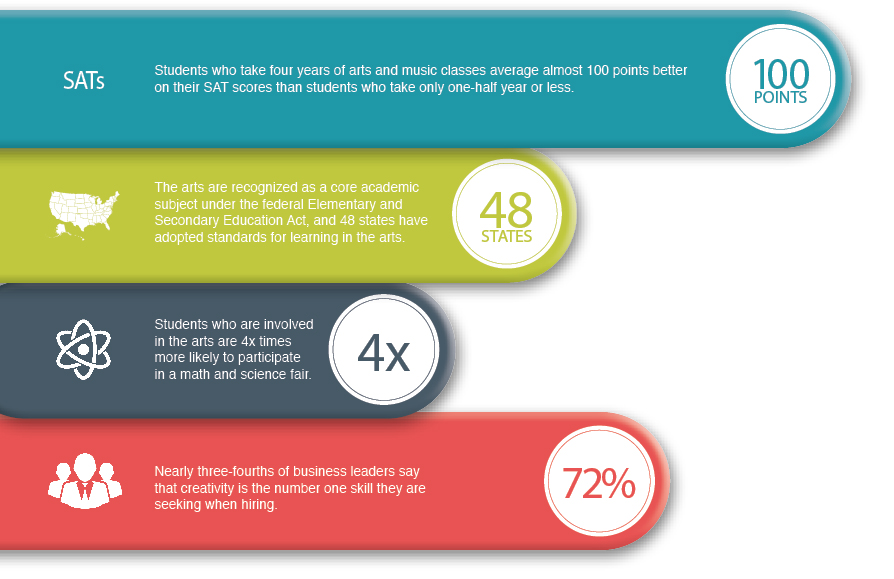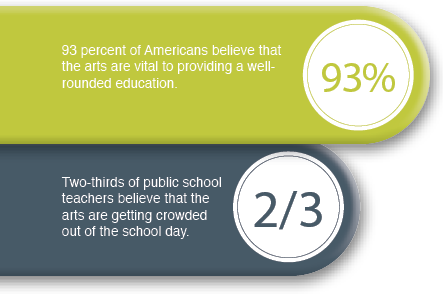Full “STEAM” Ahead
Helping Kids to Succeed at School
For years, education experts and legislators have tussled with defining best practices for teaching our students. Still, we’re left with this foundational question: “What does my child need to know to succeed?” With the newest education law, the Every Student Succeeds Act (ESSA), we’re closer to an answer.
You might have heard of STEM—Science, Technology, Engineering, and Math—which in recent years has formed the basis of standardized testing. Our country’s focus on STEM originated from a sense of “competition” with students in other countries who were excelling in these areas. The new legislation has opened the door to what some are calling “STEAM.” “A” is for the Arts.
Why the change?
The answer is creativity. It took time, experience, and research for people to realize what really makes effective learners and workers. Creativity not only improves academic performance in the short term, but also it is the primary skill that between 70 and 80 percent of North American business leaders are looking for when they hire employees. And when it comes to science, Americans for the Arts reports that Nobel laureates in the sciences are 17 times more likely to be actively engaged in the arts than are other scientists.
“Students with an education rich in the arts have higher GPAs and standardized test scores, (along with) lower drop-out rates—benefits reaped by students regardless of socio-economic status,” writes Randy Cohen, VP of Research and Policy for Americans for the Arts. “Students with four years of arts or music in high school average 100 points higher on the verbal and math portions of their SATs than students with just one-half year of arts or music.” He adds that 89 percent of Americans believe that arts are part of a well-rounded K-12 education.
Implementation
Even with the new ESSA legislation, how and how much the arts are integrated into curricula across the country are still up to states and local school districts to implement. Mary Stadick Smith, a spokesperson for South Dakota’s Department of Education (DOE), says that in the year-plus since the new legislation was signed into law, several work groups have delved into the details—both of the law and of education priorities for South Dakota. “Now we’re in the process of engaging with parent groups, tribal representatives, and other stakeholders to get their thoughts,” she says. This information will contribute to our state’s education plan, which will be submitted to the federal DOE this fall.
Although Stadick Smith expresses concern about funding under the new law to integrate arts programs specifically, the South Dakota Arts Council (SDAC) sees new possibilities. “These new provisions actually open up funds that can be used for arts education,” says SDAC Assistant Director Rebecca Cruse. Therefore, if parents want more focus on the arts, they’ll have to make sure to say so. Cruse reminds parents, teachers, and administrators to reach out to the their local school districts and the Department of Education in order to consider creative ways to use these funds.

The Stats on the Impact of Creativity
• A student involved in the arts is four times more likely to be recognized for academic achievement, four times more likely to participate in a math and science fair, three times more likely to win an award for school attendance, and three times more likely to be elected to class office.
• The arts reach students who might otherwise slip through the cracks, or who have different-than-average learning styles.
• The arts create a feeling of connection and cooperation among students.
• Four percent of low-income students with high arts engagement drop out of high school, as compared with 22 percent for those with low engagement. Likewise, these students are more than twice as likely to graduate college as their peers with low arts engagement.
All figures courtesy of Americans for the Arts.

The New Law at a Glance
The reason for upgrading the education law, according to the US DOE: “No Child Left Behind, the previous version…exposed achievement gaps among underserved students and their peers and spurred an important national dialogue on education improvement.” The result is change that focuses on the following points, among others:
• Advances equity for America’s disadvantaged and high-need students, and supports our lowest-performing schools.
• Targets the education needs of American Indian, Alaska Native, and Native Hawaiian students; in South Dakota this means greater autonomy for the Bureau of Indian Education, with oversight by the US Secretary of Interior.
• Requires—for the first time—that all students in America be taught to standards that will prepare them to succeed in college and careers.
• Expands the definition of “well-rounded education” to allow room for various arts disciplines as core subjects.
• Helps to support and grow local innovations, meaning that each state has significant
input as to how its children are best served.
By Kristin Donnan

